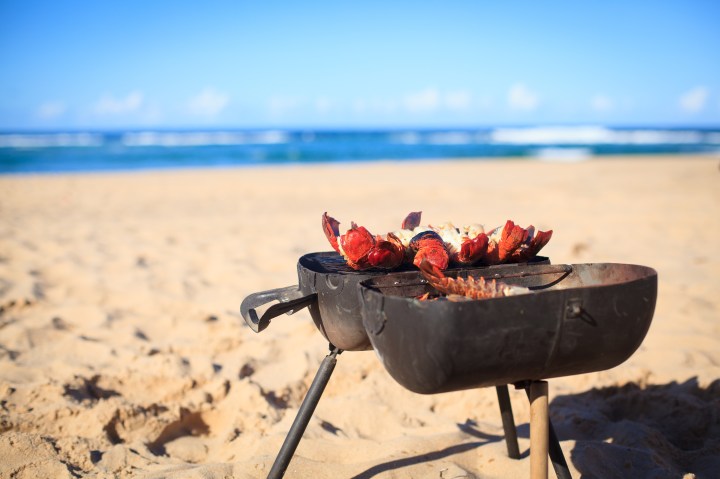KAROO KITCHEN
Kreef, scarlet jewel of the Succulent Karoo

There was nothing more delightful in my mom’s kitchen or on my dad’s braai than a succulent lobster plucked from the wild sea that morning.
The Karoo sea. Yes, the Karoo has beaches, ocean, crashing waves and danger. And there are few seas wilder than the rumbling, tumbling roar of the saltwater that crashes onto the beaches of Oranjemund, Lüderitz and Port Nolloth.
I had always been a Karoo boy, though I didn’t know it. When we drove from Oranjemund, down via Port Nolloth and west towards Steinkopf and Springbok to find the road all the way to Cape Town, we were driving through Karoo. Even Lüderitz, where the sea is yet wilder, is in this farflung region of the endless old Garob; or, it is now.
My dad, from whom I inherited a certain timidity, was not one to wade into those deadly waters near the mouth of the Orange River himself, but a sturdy bloke down the road would, on an occasional Sunday, arrive at our back door with a bag of rustling, fidgety kreef ready for the pot.
They were giants, their tails long and plump, and so well grown that there was plenty of white meat well into the carapace. One day I walked through the back door to find six large lobsters shuffling around on the kitchen floor. They’d made an escape from the fridge after someone had left the door ajar. There was much screaming and hurtling out the back door.
But they were soon corralled and ended up on the braai that evening, basted with lemon butter, my folks not being fond of garlic. This was typical of that British expat generation who had grown up in England with no hint of garlic anywhere. Their son quickly caught up and made up for lost garlic time.
But, truth be told, kreef needs no garlic anyway. It is great with it, but crayfish flesh has so much flavour all of its own that there’s little point in imposing any other flavour on it at all. I feel the same way about oysters: I prefer them au naturel, no lemon, no pepper, no Tabasco, nothing. Just straight down after a pleasant chew, especially if they’re meaty ones like those you find in Lüderitz.
There’s something about proximity to the beach that improves the flavour of crayfish, and all seafood for that matter. There’s a trendoid habit in some very posh restaurants of including vapours of one kind or another in a dining experience. When you’re near the sea and eating kreef, the smell of the salty brine seems to enhance the flavour and even the texture. So those refined chefs are indeed onto something, even if there is a certain pretentiousness about it.
Being right on the (Karoo) beach with the sand between your toes, and pulling the luscious white meat out of the carapace with your fingers, is a true blessing that makes you grateful for Neptune’s abundant largesse.
The Succulent Karoo is ancient but relatively “new” in being described as such. The ecoregion was dubbed this by the World Wide Fund for Nature and while it might not “correspond to the actual Karoo”, says Wikipedia, all of us who call the Karoo home know that “the Karoo” is more than a mere geographical demarcation. The Wikipedia entry says that “the Succulent Karoo stretches along the coastal strip of southwestern Namibia and South Africa’s Northern Cape province, where the cold Benguela Current offshore creates frequent fogs. The ecoregion extends inland into the uplands of South Africa’s Western Cape province. It is bounded on the south by the Mediterranean climate fynbos, on the east by the Nama Karoo, which has more extreme temperatures and variable rainfall, and on the north by the Namib Desert.”
The glorious Namaqualand with its purple rock faces and otherworldly trees and succulent shrubs runs through this terrain, the land we meandered through on our annual escape from the Diamond Dorp to the relative civilisation of the Western Cape. But the passing years and the wisdom (one hopes) it brings make us realise just how expansive the places of our beginnings were and how deeply our roots run in those hot sands.
The whole of the Karoo and its many parts are like that. What might appear to be useless veld, which more often than not is in dire need of rain, is in fact full of life of millions of kinds, both fauna and flora. The succulent holds its water reserves jealously in the face of the beating sun. Scarab beetles nibble on succulent flowers. In the Sperrgebiet, the Nama Padloper tortoise munches on cacti and any desert flower or fruit it finds and stores the water it inherits from them for an entire year if need be.
With the desert wind on your face and the aromas of the sea in your nostrils, wriggle your toes into the beach sand of the Succulent Karoo to dine on the salty white flesh of Karoo Kreef, Neptune’s blessing and gift to the coastal dwellers of the Garob. (Find the recipe for Kreef Mayonnaise here.) DM/TGIFood
Follow Tony Jackman on Instagram @tony_jackman_cooks. Share your versions of his recipes with him on Instagram and he’ll see them and respond.
SUBSCRIBE to TGIFood here. Also visit the TGIFood platform, a repository of all of our food writing.




Comments - Please login in order to comment.